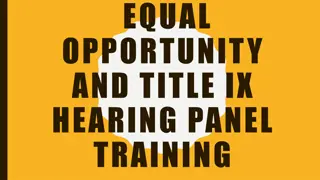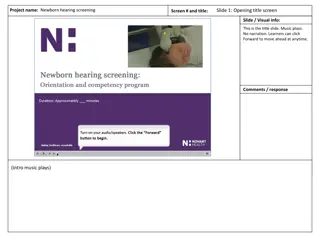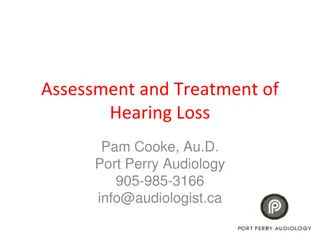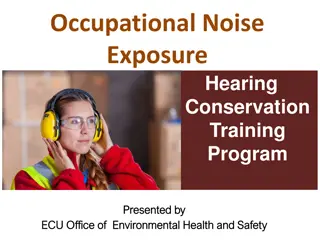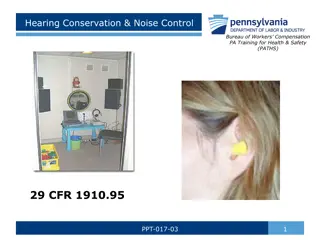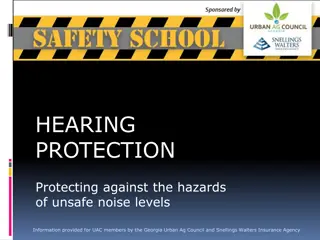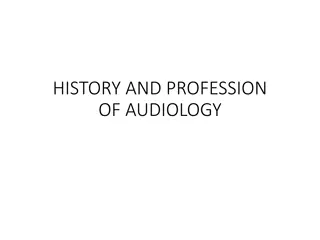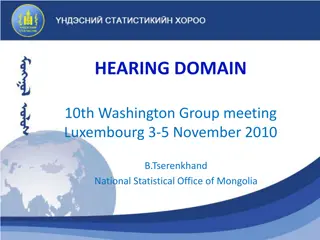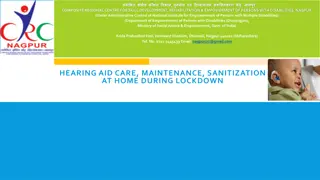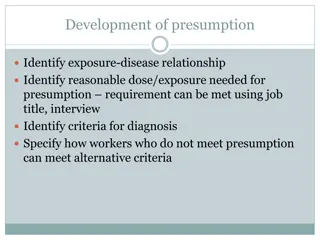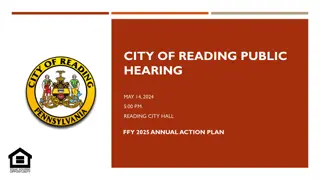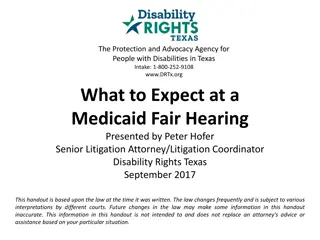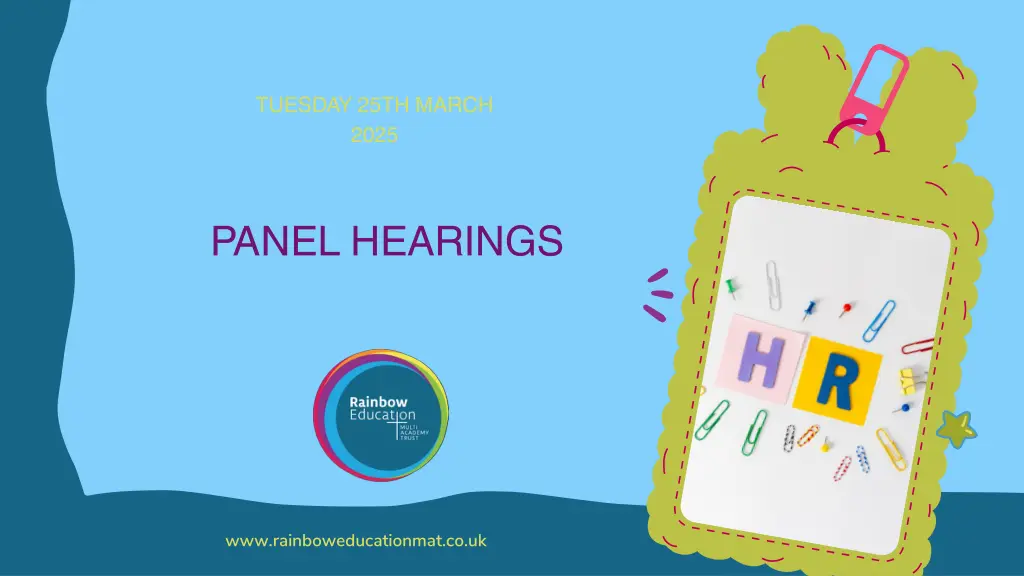
Understanding Disciplinary Procedures in the Workplace
Learn about the importance of handling employee relations issues effectively, the law on unfair dismissal, investigation plans for disciplinary matters, and the process when no case is found to answer. Discover the key principles and steps to ensure fair treatment and maintain healthy working relationships.
Download Presentation

Please find below an Image/Link to download the presentation.
The content on the website is provided AS IS for your information and personal use only. It may not be sold, licensed, or shared on other websites without obtaining consent from the author. If you encounter any issues during the download, it is possible that the publisher has removed the file from their server.
You are allowed to download the files provided on this website for personal or commercial use, subject to the condition that they are used lawfully. All files are the property of their respective owners.
The content on the website is provided AS IS for your information and personal use only. It may not be sold, licensed, or shared on other websites without obtaining consent from the author.
E N D
Presentation Transcript
TUESDAY 25TH MARCH 2025 PANEL HEARINGS www.rainboweducationmat.co.uk
Introduction Types of hearing Disciplinary Grievance Capability Attendance Agenda Effective questioning Right to appeal Role of unions
The law on unfair dismissal requires employers to act reasonably when dealing with employee relations issues. What is classed as reasonable behaviour will depend on the circumstances of each case, and is ultimately a matter for employment tribunals to decide. However, the core principles are set out in the Acas Code of Practice. Introduction Employers and employees should always seek to resolve issues in the workplace. If employee relations issues such as discipline and grievance are settled at an early stage they are normally less time-consuming and less likely to damage working relationships.
Investigation Plan What needs to be investigated Who is carrying out the investigation 'Witnesses' anyone who needs to be spoken with to find out about the issue Any sources of evidence, for example work records, emails or CCTV recordings Any time limits, for example CCTV footage being deleted or staff going on leave Timeframes Policies or organisation guidelines to follow Whether the person investigating is expected to give recommendations at the end of the investigation setting out the importance of confidentiality any other relevant points or information Disciplinary Investigation
Where the investigating officer determines that the evidence collated does not support the need to proceed to a hearing, no reference will be made to the issue on the employee s personnel file and for all allegations, other than those of a safeguarding nature, documents collated as part of the investigation will be destroyed. The employee will be advised accordingly in writing and, if suspended, the employee will return to duty as soon as is reasonably practicable. Disciplinary No case to answer Where the allegations relate to safeguarding a clear and comprehensive summary of the allegations made, details of how the allegation was followed up and resolved, and a note of any action taken and decisions reached, will be kept on the employee s confidential personnel file. A copy of the information will be provided to the employee concerned. The record should be retained at least until the employee has reached normal retirement age or for a period of 10 years from the date of the allegation if that is longer.
It is the responsibility of the investigating officer to consider at what level the allegation(s) should be considered. Only allegations considered as gross misconduct may result in summary dismissal (ie dismissal without notice) The following is a non-exhaustive list of examples of gross misconduct, taken from the ACAS Guide: - theft or fraud physical violence or bullying deliberate and serious damage to property serious misuse of an organisation s property or name deliberately accessing internet sites containing pornographic, offensive or obscene material serious insubordination unlawful discrimination or harassment bringing the organisation into serious disrepute serious incapability at work brought on by alcohol or illegal drugs causing loss, damage or injury through serious negligence a serious breach of health and safety rules a serious breach of confidence. Disciplinary Gross misconduct
Should only apply in circumstances where the employee's presence at work would either jeopardise the fairness of the ensuing investigation or where their presence could pose a potential threat to the school, pupils or other employees. Suspension should only be used as a last resort, and not as a 'knee-jerk' reaction. Disciplinary Suspension After a gross misconduct allegation arises against an employee an appropriate manager should immediately collect as much information as possible relating to the conduct that could warrant suspension prior to a decision to suspend being made - this does not mean that the formal Investigation / Disciplinary process has started and the details should not be discussed at the suspension meeting. If the school believes there is a gross misconduct case to answer they will then start the formal Investigation / Disciplinary process.
Appropriate alternatives to suspension should be considered. A written record setting out why the employee was suspended should be kept. The initial decision on suspension is made by the Head Teacher but the Chair of Governors will be informed. Any extension will be authorised by the Chair of Governors. Disciplinary Suspension The school should consider the effect suspension will have on the employee.
The point of the meeting is to establish the facts, not catch people out. Set the agenda introduce those present to the employee and explain why they are there introduce and explain the role of the accompanying person if present explain that the purpose of the meeting is to consider whether disciplinary action should be taken in accordance with the disciplinary procedure explain how the meeting will be conducted. Disciplinary Hearing
The Chairperson of the Disciplinary Committee/Head teacher will make introductions and explain the purpose of the meeting and the structure of the meeting. The Chairperson/Head teacher will ensure that the employee is in receipt of all the relevant documentation and that the allegations are understood. The Investigating Officer will present the case against the employee in their presence and may call witnesses. The employee or their representative may ask questions of the Investigating Officer and witnesses. The Disciplinary Committee/Head teacher may ask questions of the Investigating Officer and witnesses. The employee or their representative will present the employee s response in the presence of the Investigating Officer and may call witnesses Disciplinary Hearing
Statement of the complaint Employee s reply General questioning and discussion establish the facts employee explanation. mitigating factors to be considered is there a case to answer? Use questions to clarify and check for understanding If new facts emerge it may be necessary to adjourn the meeting Summing up Adjournment before decision Possible problems grievance raised employee becomes angry/upset Disciplinary Hearing
The Disciplinary Committee/Head teacher may ask questions of the Investigating Officer and witnesses. The employee or their representative will present the employee s response in the presence of the Investigating Officer and may call witnesses The Investigating Officer may ask questions of the employee and witnesses The Disciplinary Committee/Head teacher may ask questions of the employee and witnesses The Investigating Officer sums up The employee or their representative sums up The Chairperson asks the employee if they feel that the hearing has been fair. Both parties withdraw while the Disciplinary Committee/Head teacher deliberate. Should the Disciplinary Committee/Head teacher wish for clarification from either party, this will be done in the presence of both parties The Disciplinary Committee/Head teacher will invite both parties back to hear the decision. Disciplinary Hearing
No sanction Verbal warning Disciplinary Hearing Outcomes Written warning Final written warning Dismissal with notice without notice
Informal stage informal face to face meeting listen to employee concerns seek clarification discuss the impact of the concerns seek to address and resolve the issues offer support - EAP etc follow up in writing arrange review meeting Formal stage - investigation put grievance in writing manager to escalate to a more senior manager appoint a Formal Stage Manager consider relevant information such as documentary evidence Grievance Stages of the procedure
No further action Complaint upheld / partially upheld A recommendation to attempt to resolve the issue between the parties A recommendation to invoke the disciplinary procedure against any person(s) being complained about A recommendation to invoke the disciplinary procedure against the complainant, should the formal stage manager have evidence to suggest that the complaint was: malicious - ie proven to be without substance and made with the sole intent to undermine, discredit, embarrass or upset another. Or vexatious - ie. proven to be without substance and made only to annoy or cause a nuisance. Some other action eg retraining, counselling Grievance Outcomes
Linked to appraisal Capability procedure applies to teachers/headteachers where performance evidence suggests serious concerns Capability Early identification of concerns will help to avoid the need for recourse to the Capability [Performance] Policy and in most cases an improvement may be achieved with support and attention
Provide any written evidence Establish the facts Enables teacher or headteacher to repond to concerns and provide further information Initial outcomes insufficient grounds for pursuing the capability issue and that it would be more appropriate to continue to address the remaining concerns through the appraisal process. In such cases, the capability procedure will come to an end. Adjournment of the meeting for example if further investigation is needed, or more time is needed in which to consider any additional information. Capability Formal stages of the process Stage 1
Identify the professional shortcomings Give clear guidance on the improved standard of performance -setting of new objectives focused on the specific weaknesses that need to be addressed Identify any success criteria that might be appropriate and the evidence required explain any support that will be available to help the teacher improve their performance; Set out the timetable for improvement and explain how performance will be monitored and reviewed. Consider issuing a formal warning to the teacher and indicate that failure to improve within the set period could lead to dismissal. In very serious cases, this warning could be a final written warning Monitoring and review period Capability Formal stages of the process Stage 1
If improvement made capability procedure will cease and the appraisal process re- starts If some progress has been made and there is confidence that more is likely, it may be appropriate to extend the monitoring and review period. If no, or insufficient improvement has been made during the monitoring and review period, a final written warning will be issued and a final review period will be set in which to improve performance. Where a final warning is issued, the member of staff will be informed in writing that failure to achieve an acceptable standard of performance (within the set timescale), may result in dismissal Capability Formal stages of the process Stage 2
Decision meeting If performance remains unsatisfactory, a decision, or recommendation to the Governing Body, will be made that the teacher should be dismissed or the Decision Meeting will be before a Governors Committee consisting of at least three members of the School Governing Body in the event of a decision to dismiss the Teacher, they will be informed as soon as possible of the reasons for the dismissal, the date on which the employment contract will end, the appropriate period of notice and their right of appeal Dismissal once the Governing Body has decided that the teacher should no longer work at the school, it will notify the Local Authority /Trust of its decision and the reasons for it. Capability Formal stages of the process Stage 3
When managing sickness absence, employers must bear in mind the provisions of the Equality Act 2010. This act makes it unlawful to discriminate against workers because of a mental or physical disability, or to fail to make reasonable adjustments to accommodate a worker with a disability. Absence Management The act makes it unlawful to discriminate against people with a protected characteristic. This covers age, race, gender, disability, religious belief, gender reassignment,
The Final Stage of the Attendance Procedure is referral to the Attendance Hearing. Purpose - decide upon a course of action up to and including dismissal. Attendance Hearing should be made up of a panel consisting of not less than three members of the Governing Board. However, where this is not possible the Attendance Hearing may comprise two members with agreement by all parties Employee will be informed in writing hat a possible outcome of the hearing could be dismissal Inform the employee that they are entitled to be accompanied at the hearing by a fellow worker or a trade union representative No third party representatives are allowed. Include the procedure to be followed at the Hearing. Absence Management Attendance hearing
Managements Opening Statement of Case. Questions of Management s Opening Statement by the Employee and/or the Representative. Questions by the Panel and/or their Adviser to Management Employee s Opening Statement of Case. Questions of the Employee s Opening Statement by Management. Questions by the Panel and/or their Adviser to Employee. Summing Up by Management. Summing Up by the Employee or the Representative. Panel retires to deliberate. Decision given in writing within 5 working days. Absence Management Procedure for hearing
The line of questioning should be tailored to the specific allegations and issues of the matter. Commonly asked questions which can help to shape your meeting preparation Confirmation of employee understanding seek confirmation that the employee understands why they are at the meeting and the possible consequences they face, and that they have been provided with all required information Questions could include: Can you confirm you have received details in writing of the allegations against you? Do you understand the nature of the allegations being made against you? Are you aware that the behaviour connected with the investigation is unacceptable? Can you confirm they have been given access to the organisation s disciplinary procedure? Do you understand the possible consequences? What happened? Who was present? Effective Questioning
The specific questioning will depend on the nature of the issue, such as whether the issue relates to a grievance from another employee, the employee s conduct or performance or if there is alleged gross misconduct. Are there mitigating circumstances to take into account, for instance, tiredness or ill health? Responding to evidence The employee should be given the opportunity to explain or comment on the evidence being relied on. Closing the employee should be asked if there is anything more they would like to add or ask. the employee should be allowed to look at the meeting notes and sign and date the document as a true reflection of the discussion. A copy of this record should then be forwarded to the employee. This can prove invaluable in the event of any subsequent allegations that the hearing was conducted unfairly. Effective Questioning
Submitted in writing or by email to the Chair of the Hearing within five working days of receiving written (or email) notification of the outcome of ao the hearing. The written appeal must detail, concisely, the grounds for any appeal. All appeals will be heard by a panel of governors who have not previously been involved in the case. Right to Appeal Appeals will be heard, normally, within 20 working days of receipt of the written appeal. Where this is not possible the Employee will be advised of this in writing or by email. The procedure to be followed at the appeal hearing will be sent to the employee in advance of the meeting.
The Appeal will be by way of a review, only, of the issues raised in the written appeal. The Local Academy Council members hearing the appeal will consider whether the original decision was reasonable, taking account of any new information not available at the time of the original decision. The original decision may be set aside (ie. Overturned) or not. Right to Appeal The employee will be notified in writing of the outcome of the Appeal within five working days of the appeal being heard. There is no further internal right of appeal against a decision of the Appeals' Panel. In the event of an appeal being upheld and the person being reinstated, pay will be appropriately backdated.
Read through all of the evidence Consider questions which may be asked to be asked in the hearing (which will Note the answers you want to give. 3. Decide if you want to make a statement at the start of the hearing and write it in advance List the points the employee wants to raise and discuss Help with a chronology of events review evidence bundle and consider if anything else needs to be added Consider whether there are any other witnesses the employee would like to be questioned at the hearing - they will advise that that witnesses are only helpful at disciplinary hearings if it is known what they are going to say. Open and honest relationship - not holding any information back Mediation Role of the Union Rep

